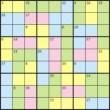 Barbie might think math is hard, but perhaps she’d be willing to try this game. I just heard about it yesterday around the water cooler copier (Thanks Lynn!). It’s a little bit like Killer Sudoku, but with operations other than just addition.
Barbie might think math is hard, but perhaps she’d be willing to try this game. I just heard about it yesterday around the water cooler copier (Thanks Lynn!). It’s a little bit like Killer Sudoku, but with operations other than just addition.
The initial grid is a square, perhaps 4×4 or 6×6. Like Sudoku, the digits 1-4 or 1-6 are put in cells so that each row contains exactly one of the digits and each column contains exactly one of the digits.
In addition, there are groups of cells (like the cages in Killer Sudoku). In the corner is a number and an operation. If the digits in a group are put together with that operation, they form the given number. For example, if there are two cells with “8x” in the corner, the digits multiply to 8, and so must be 1&8 or 2&4 in some order. Likewise, “2/” (using / for division) could be 1&2, 2&4, 3&6, or 4&8 where the pairs are in either order. While you can’t repeat digits in any row or column, you can repeat digits in a group of cells.
Here’s one to try, courtesy of SGBailey.

(You can find the answers in the place that always gives you answers.)
If you search for KenKen there seem to be several sites where you can get your daily fix (including the New York Times), but most require registration. And apparently in some of the harder versions the operation is left off so that you know the answer, but not whether it is a sum, product, quotient, or different. I can totally imagine a variation that uses multiple operations in a single group of cells, but as far as I know that hasn’t been invented yet.








 The Number Warrior
The Number Warrior

 Barbie might think math is hard, but perhaps she’d be willing to try this game. I just heard about it yesterday around the
Barbie might think math is hard, but perhaps she’d be willing to try this game. I just heard about it yesterday around the 




 So you bought a
So you bought a  In a comment on
In a comment on 
